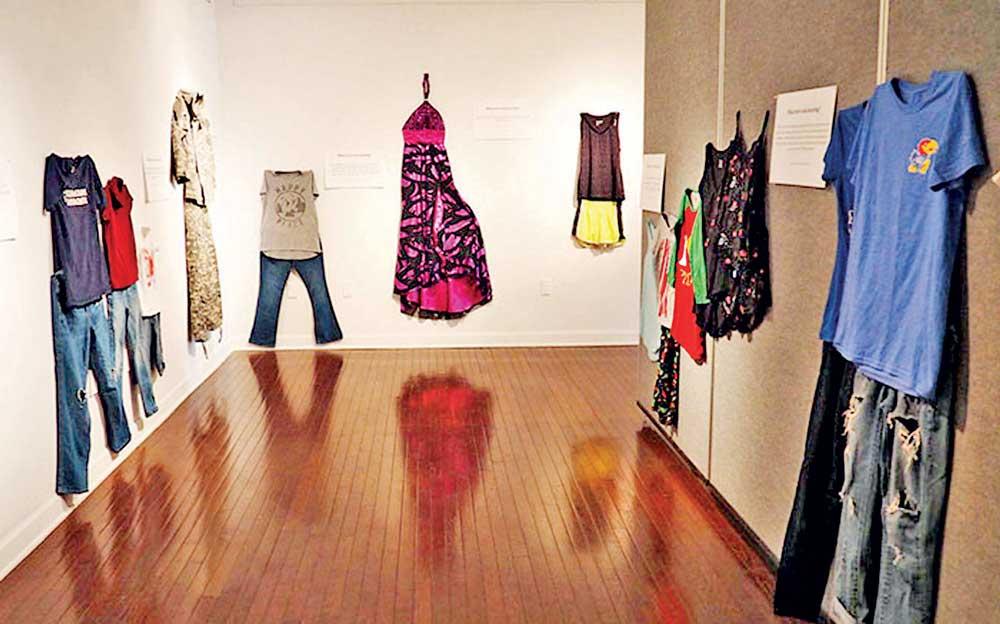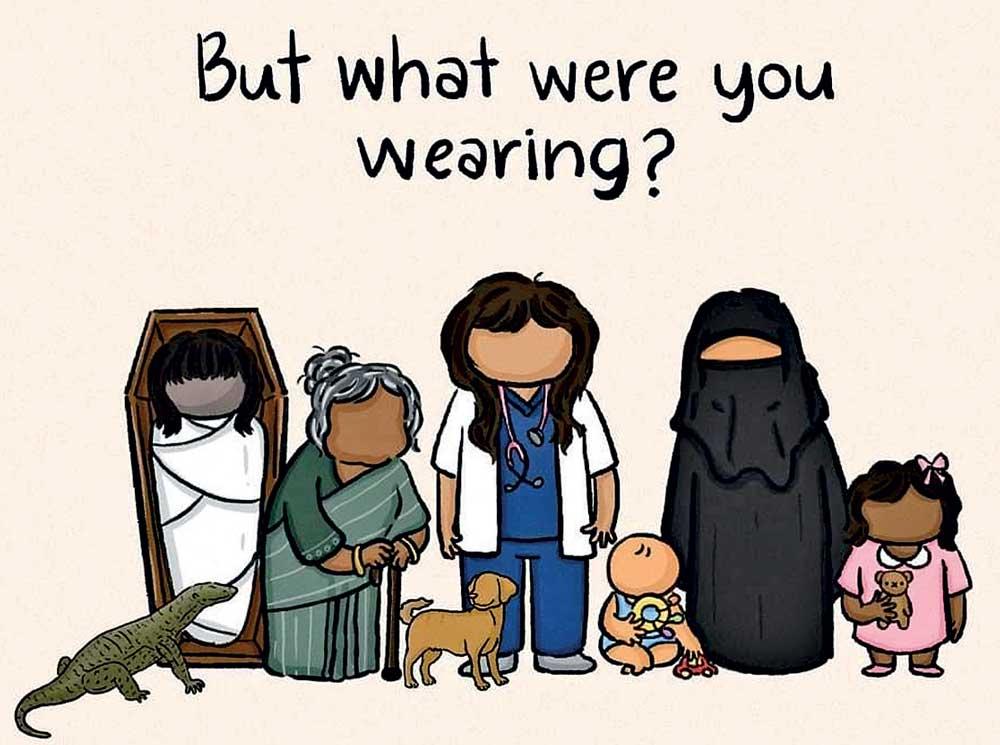Reply To:
Name - Reply Comment
The Perils of Victim-Blaming
 The "What Were You Wearing?" art installation, created by Dr. Wyandt-Hiebert and Ms. Brockman, challenges the myth that victims are responsible for their assaults.
The "What Were You Wearing?" art installation, created by Dr. Wyandt-Hiebert and Ms. Brockman, challenges the myth that victims are responsible for their assaults.
Society sends a dangerous message that women are responsible for preventing their own assaults, rather than holding perpetrators accountable for their actions.
 Every time a sexual assault makes the headlines, the same infuriating question comes up: "What was she wearing?". Instead of focusing on the crime and the criminal, society fixates on the victim, as if a piece of clothing could somehow explain or excuse the violence inflicted upon her. It’s not just frustrating; it’s a gross miscarriage of justice. This line of thinking shifts the blame from the perpetrator—the person who chose to commit an act of violence—to the victim, as if her outfit or behaviour were the real culprit.
Every time a sexual assault makes the headlines, the same infuriating question comes up: "What was she wearing?". Instead of focusing on the crime and the criminal, society fixates on the victim, as if a piece of clothing could somehow explain or excuse the violence inflicted upon her. It’s not just frustrating; it’s a gross miscarriage of justice. This line of thinking shifts the blame from the perpetrator—the person who chose to commit an act of violence—to the victim, as if her outfit or behaviour were the real culprit.
In Sri Lanka, this problem is magnified by cultural norms that dictate how women should dress and behave. These expectations give people a convenient excuse to criticise and blame the victim rather than hold the attacker accountable. When a woman is assaulted, too often the first reaction isn’t to condemn the criminal, but to scrutinise her choices: Was she dressed appropriately? Was she out late? Was she somehow "asking for it"? These questions aren’t just irrelevant—they’re harmful. They send a message that women are responsible for preventing their assaults, while the men who commit these crimes get a pass.
This kind of victim-blaming is more than just unfair; it’s dangerous. It protects the guilty and shames the innocent, creating a culture where survivors of sexual violence are discouraged from coming forward. They know that instead of finding support, they might face judgment and blame. And every time this happens, it reinforces the idea that it’s the woman’s job to avoid being raped, rather than society’s job to stop men from raping. It’s a disgusting distraction from the real issue: holding the perpetrators accountable for their actions. In Sri Lanka and beyond, it’s time we stop asking what she was wearing and start asking why we’re not doing more to protect women and prosecute their attackers.
The Myth of the
Provocative Dress
In Sri Lankan society, where traditional values and cultural norms often dictate women's attire, the notion of "provocative dress" is a pervasive and harmful belief. This myth suggests that a woman's clothing can somehow invite or justify sexual violence. This harmful stereotype is deeply rooted in patriarchal thinking, where women are often seen as responsible for managing men's behaviour.
When a sexual assault occurs, questions like "What was she wearing?" or "Was she asking for it?" are disturbingly common. Such attitudes not only undermine the severity of the crime but also place an unjust burden on women to conform to restrictive standards of behaviour. By perpetuating the myth of provocative dress, society sends a dangerous message that women are responsible for preventing their own assaults, rather than holding perpetrators accountable for their actions.

Photo credit: Happy Fluff Comics / Facebook
“When I was sexually assaulted, I was very ashamed and couldn’t find the courage to tell anyone I knew, so I posted it anonymously online hoping for some words of kindness and support” Zainab** shared. “Doing so turned out to be a mistake. I was questioned mercilessly in the comments. A recurring question was ‘What were you wearing?’. It broke me completely to be accused when the one who did it to me should have gotten all this hate. To answer their question - What was I wearing? I was wearing a niqab”.
Shobi’s** story is similar. She was wearing a shalwar kameez at the time. But it didn’t matter. “People were saying maybe it was figure hugging. That it probably had a deep neckline. ‘Men don’t rape for no reason’. I was sick to my stomach. Instead of support, I was being blamed.”
The Implications of Victim Blaming
Victim blaming isn’t just a misguided response to sexual violence; it’s a dangerous mindset that ripples through society with devastating effects. When we blame the victim, we’re not just excusing the perpetrator—we’re compounding the trauma of those who’ve already suffered. Imagine surviving something as horrific as sexual assault, only to be met with a barrage of accusations questioning your behaviour, your choices, and your very identity. It’s no wonder that so many survivors are reluctant to come forward. Who would want to relive their trauma, only to be treated as if they’re the ones on trial?
This culture of blame doesn’t just harm individual survivors; it creates a chilling effect that reaches far beyond any one case. When we consistently put the spotlight on what the victim did or didn’t do, we send a clear message to others: If this happens to you, you’ll be judged too. This fear of being shamed or disbelieved silences countless victims, leaving them to suffer in isolation. It’s a cruel irony—society demands that victims report their assaults, yet punishes them when they do.
Holding Perpetrators Accountable
When it comes to sexual assault, the focus should never be on what a woman was wearing or what she might have done to "provoke" her attacker. Yet, this is exactly where society often fixates, conveniently overlooking the undeniable fact that the real issue is the actions of the perpetrator. Let’s be clear: sexual violence is a deliberate choice made by the assailant, and no outfit, behaviour, or circumstance can justify it. If we want to tackle this problem head-on, we need to shift the conversation away from victims and squarely onto those who commit these heinous acts.
Holding perpetrators accountable isn’t just a legal obligation—it’s a moral one. This means more than just passing stricter laws or increasing police presence. It requires a fundamental shift in our collective mindset. We need to stop looking for excuses and start demanding justice. This involves educating people from a young age about consent, respect, and equality. It means implementing prevention programs that don’t just tell women how to avoid assault but teach everyone that sexual violence is unacceptable under any circumstances.
But education alone isn’t enough. We need a justice system that takes these crimes seriously. Too often, perpetrators are let off with a slap on the wrist, if they’re held accountable at all. This sends a dangerous message that sexual violence isn’t a serious offence, further emboldening predators. We need to enforce strict legal consequences for offenders, ensuring that those who commit sexual assault face real repercussions for their actions. This isn’t just about punishing the guilty; it’s about setting a precedent that society won’t tolerate such behaviour.
Holding perpetrators accountable also means dismantling the harmful stereotypes that perpetuate sexual violence. The idea that women are somehow "asking for it" based on their appearance or behaviour is not only outdated but deeply toxic. We must challenge and reject these stereotypes at every turn, replacing them with a culture that promotes true gender equality. In such a society, survivors of sexual assault would be believed and supported without having to defend their choices or their character. They wouldn’t be forced to relive their trauma in courtrooms or in the court of public opinion but instead would find justice and healing.
Creating a society that truly stands up for justice requires more than lip service; it demands action. It’s time we stopped deflecting blame onto victims and started holding those who commit sexual violence accountable in every sense—socially, legally, and morally. Only then can we hope to break the cycle of violence and build a future where everyone is safe and respected, no matter what they wear or how they live their lives.
In the end, victim-blaming isn’t just unfair—it’s a moral failure. It allows the cycle of violence to continue unchecked, while survivors are left to carry the burden of guilt and shame that rightfully belongs to their attackers. If we’re serious about ending sexual violence, we need to stop blaming the victims and start focusing on what really matters: holding perpetrators accountable, educating our communities, and strengthening the legal protections that should be safeguarding all women, no matter what they’re wearing.
**Names have been changed to protect privacy.